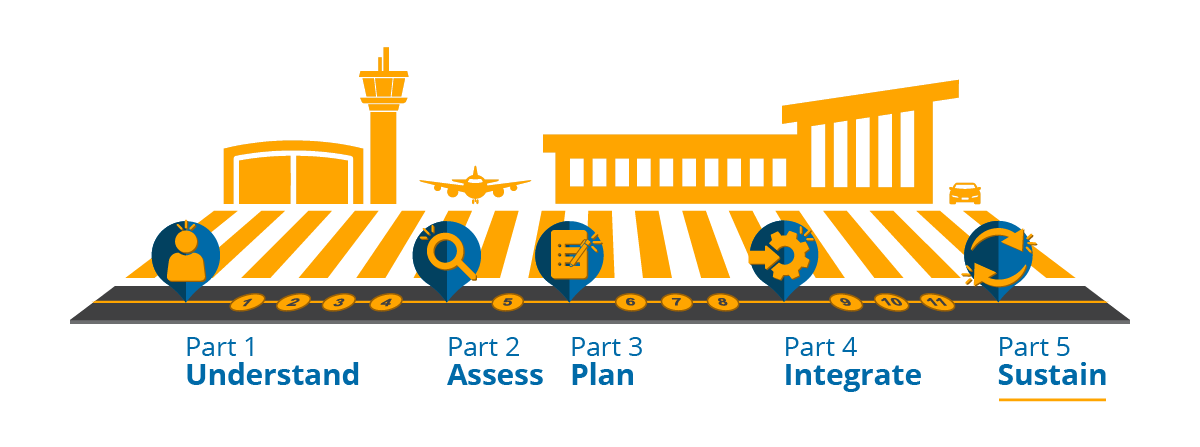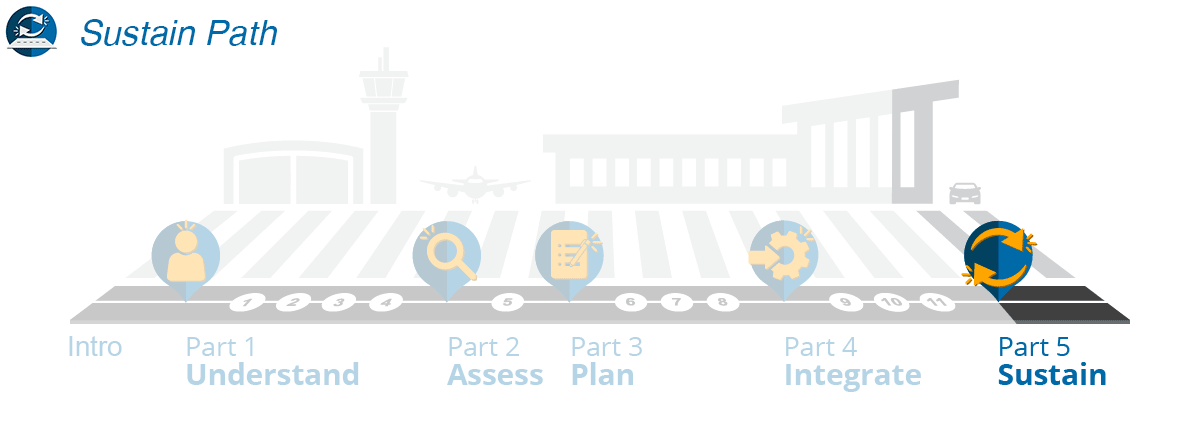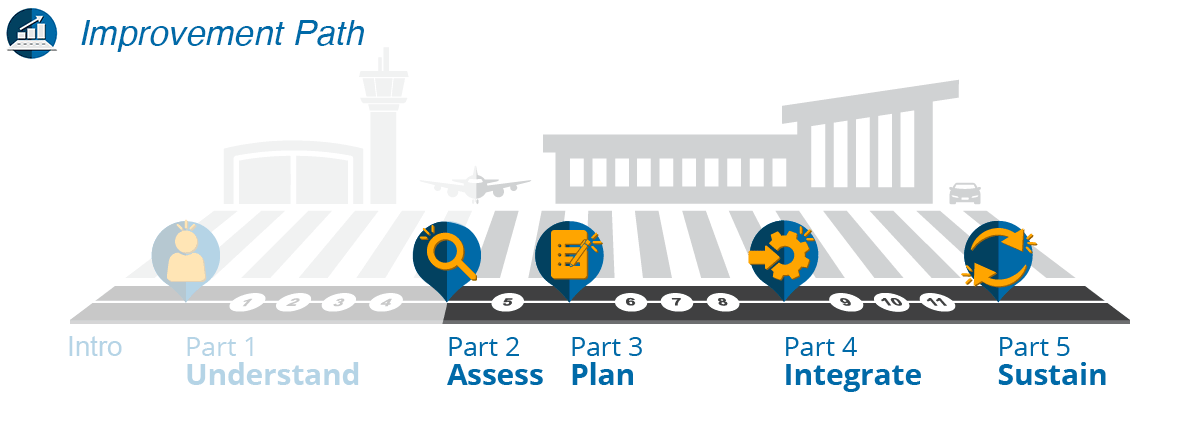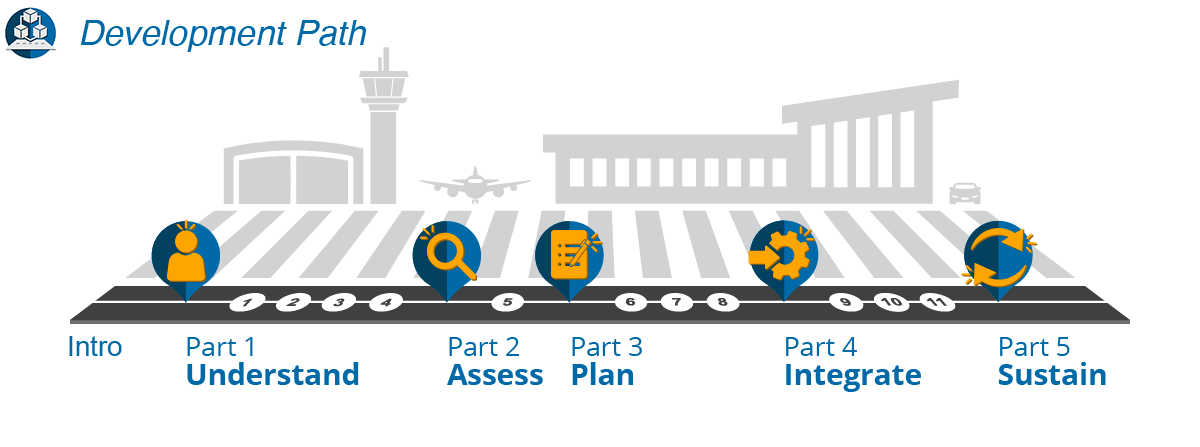
Part 5: Sustain
Learning More: The Art of Staying Current
While all commercial disciplines advance—households can be run by voice command and airplanes can practically fly themselves—staying current in social technology is particularly challenging given the pace of innovation as a global digital transformation takes hold. This simply means that whatever social media (SM) you used yesterday will be out of date tomorrow. The good news is that a well-reasoned plan, combined with the relatively stable technology adoption curve of travelers (you can assume smartphones will be with us for the near future, for example), you can expect anything you develop to remain relevant and provide value for a few years. Continue to track technology and trends in social media, looking for advancements that develop sufficiently to cause a “replanning” effort. That said, against the timescale of airport infrastructure planning, a few years is not that long. This means you must keep your knowledge and command of technology current.
Enhancing Your Training Plan
The art of staying current starts with an enhanced training plan. How will your training plan stay current beyond the efforts you put in as part of sustaining stakeholder collaboration? What are your career, team, and long-term professional objectives? These are the design points for your learning path.
Suppose, for example, that you have implemented SM listening and an early alert system and that you have in place the basics of outbound SM publishing. With those, you can spot issues early and address them in a coordinated manner using SM plus other existing communication tools. That is a great starting point for an airport newly adopting SMEM.
However, to guide your team and your facility in the next steps, you will need to understand where technologies supporting distributed real-time alerting are heading. You will also need to understand the ways in which information flows to travelers and other stakeholders in your airport. Who controls the monitors at the gates? How about the TV screens in the food court? Chances are these are two different systems entirely; so you will need to learn about onsite video distribution before you can integrate these resources into your program. In that case, learning about this topic needs to be added to your personal training plan and to the team’s training plan.
Here is why this matters: your personal training plan and your team's training plan are initially about mastery of the tools you have just deployed. Going forward, what you also have to consider is advancing the collective ability of your entire team. Think beyond the current applied technology and imagine what is possible; then frame that in terms of “what is useful” given your airport’s business and operational objectives. This often requires a mindset shift in what continuous learning means at a practical level. So be sure to build this aspect of training and professional self-development for yourself—and your team—into your future plan.
A Resource Guide
Searching for “social technology” and “airports” or “emergency response” on the web will return thousands of results. However, many are either highly technical or are outdated (more than 5 years old can be ancient history when it comes to social technology) or both. We recommend you build a resource guide of your own that includes links to sites you know are frequently updated. This will be a key part of developing your own “future proof” training plan.
Related Technologies and Developments
Finally, some of the most powerful drivers for innovation in airport emergency management (EM) do not originate in airports at all. Air transport in general has a very strong sense of itself as unique, just like many other industries. But studying adjacent or entirely unrelated industries will help you spot truly “new” opportunities for innovation that can be applied at your airport. You do not have to invent everything. Just look around and evaluate appropriate best practices and techniques you find elsewhere.
Consider Uber and its unintended impact on cable and TV providers. For years, consumers were frustrated by—yet accepted— the practice of “morning” or “afternoon” appointments for servicing or installation of a cable box. Having to take that time from work was a hassle. But we all did it anyway, albeit grudgingly. Enter Uber. If I can see the car coming to pick me up as it approaches my office rather than standing outside in the rain, I can continue working until it is time to walk downstairs and meet the driver. Why can I not do the same with the cable guy? Ten years on, most cable providers now have mobile apps that show you where the truck is. So now, instead of having to be home “all morning,” you can go to work and leave the office when the truck is on its way to your home, meeting the driver as they pull into your driveway.
To innovate requires thinking outside the box, as they say. For you and your team, this may mean also thinking outside the airport. It means thinking not as part of an EM or airport facilities team, but rather as a flyer, as a businessperson in hurry, or a family traveling on holiday. What would help them when managing a crisis? Sort out and do that. Shift out your airport mindset and into your “at home” or consumer mindset. What technology is being used in the grocery store that might be useful in your airport? Self-checkout, for example, is very similar to automated boarding from the point of view of the person using it (although entirely different in back-end supporting technology!). Ask yourself, if an emergency happened in the store, right now—if a tornado was spotted outside—what emergency management protocols would be followed? Is there a lesson here that you can transfer to future planning in your airport (including “how not to do it”)?
As a final element in your future planning, encourage your team to look around for and report on interesting uses of social and digital technology; then, as a team, discuss where these might be useful in the context of running an airport, and in particular in a time of crisis.
Taken together, the activities of learning combined with the practice of encouraging innovation can have a substantial impact on the next revision of your SM integration.




